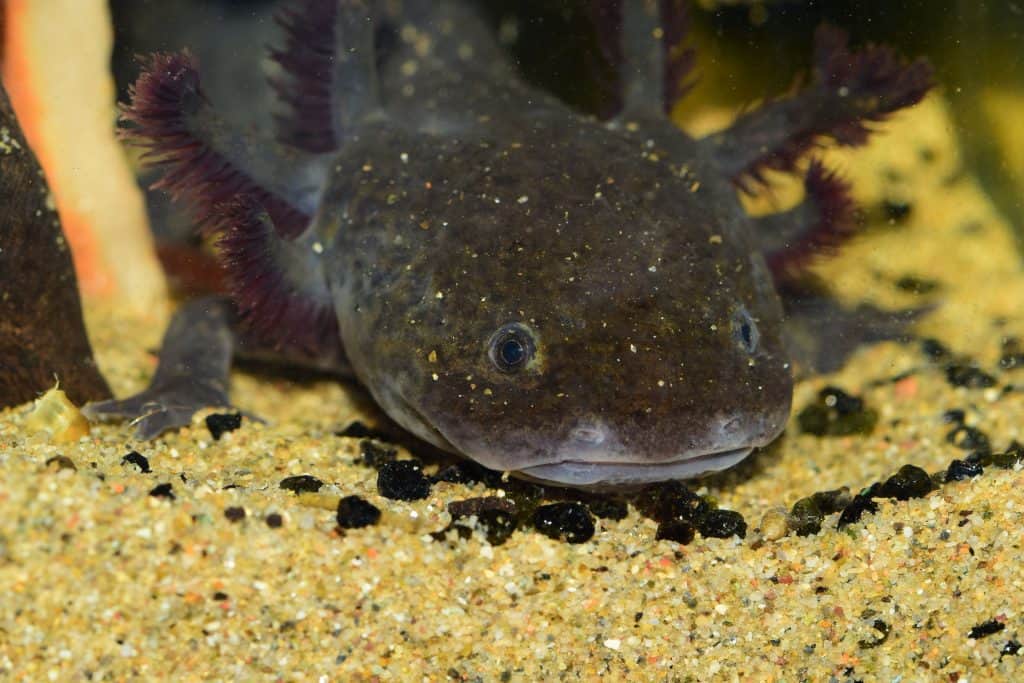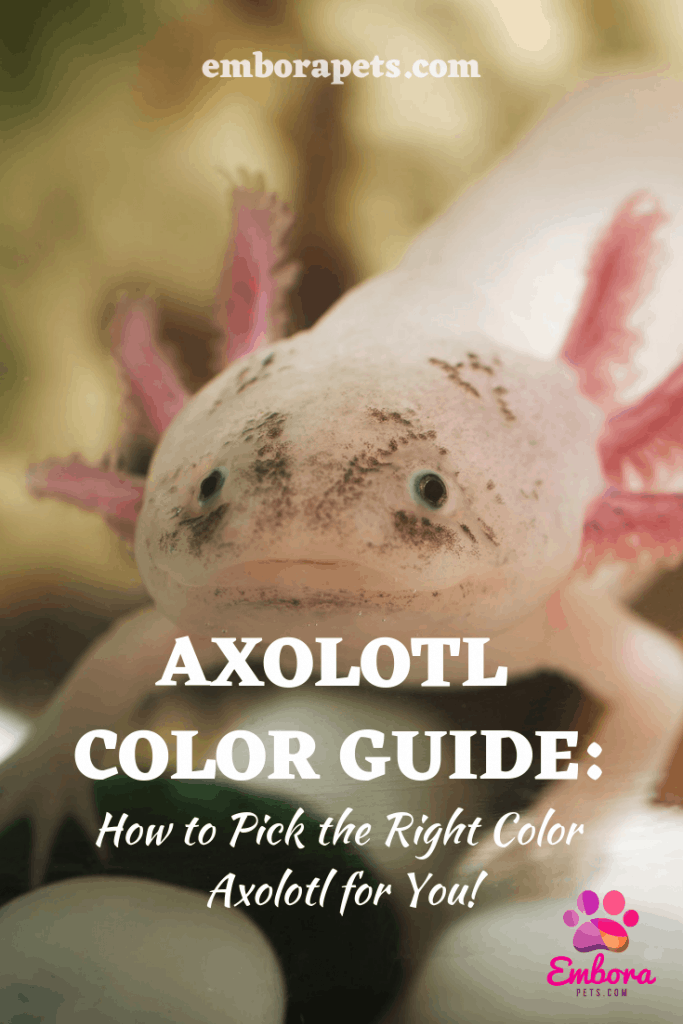Axolotl Color Guide: How to Pick the Right Color Axolotl for You!
There are so many different options of color for axolotls, but how do you know which color is best for you? I have wondered the difference myself and so I decided to do some research on the subject. Below is the information I have found.
Which color of axolotl is right for you?
There are 5 basic colors of Axolotls including, Wild, Leucistic (pink), White Albino, Golden, and Melanoid. These are the most common colors of Axolotls. The color of Axolotls is just based on the pigment of skin, so choosing a color is mostly up to personal preference of what you think looks the best.
These are just the basics, but there are many more combinations of colors that Axolotls come in. If you are interested in a more in-depth look into the basic colors, special colors, and rare colors of Axolotls then keep reading.
Basic Axolotl Colors
There are about five different basic colors of Axolotls that are most common among the Species. These include Wild, Leucistic (which is more commonly known as the pink axolotl), White Albino, Golden, and Melanoid.
Wild
The first color I’m going to cover is the one know as the Wild color. This one is one of the least self-explanatory of the basics. It includes the following traits.
- They are a combination of blacks, greens, grays, and olive coloring. These are usually speckled around the body.
- They usually start darker colored, almost looking black when they are younger, but lighten up as they mature.
- They have golden or iridescent specs around their body that make them shiny and almost glittery.
- The center of their eyes are black and have a golden or shiny ring around them.
- They usually have grayish or purplish gills.
Leucistic
The next color is the Leucistic color. This color is better known as the Pink Axolotl and in my opinion one of the prettiest and most unique. This color includes the following traits:
- The body of this Axolotl is a very light or pale pink color.
- They have very dark black or brown eyes, which is a trait that sets them apart from the white albino axolotls.
- Their gills are a dark red or very deep pink.
- It is also possible for them to develop specs or freckles on their body depending on the environment in which they are kept.
White Albino
The next color is the White Albino Axolotl, which is very comparable to the Leucistic color. They lack pigmentation in their skin which makes them white. They have the folowing traits:
- They have a white body with no specs or freckles, which will never develop even with time.
- Their eyes are clear with red centers, because of the lack of pigmentation.
- The only real color they possess is in their gills, which is a deep red color.
- They also may get dark fingertips when they are on their way to sexual maturity.
Golden
Next is the golden color which is another form of albinism. Instead of white, they appear golden. Below is a list of traits they possess:
- They have clear eyes due to the albinism, and cannot have black eyes.
- Their body is a golden or peachy color and is in patches.
- Their body also has shiny speckles or patches around it.
- The gills are a peach color.
Melanoid
Last but not least for the basic color is the Melanoid color. This color can often be mistaken for a dark Wild color, but have some key differences. These are the traits they possess:
- They have an increased amount of pigment in their skin which makes them have a very dark brown or black color for their bodies.
- They lack any iridescent or shiny specs in their skin which is the biggest separating factor from the Wild color.
- They are one solid black color which also means their gills and eyes are black.
Special Colors of Axolotls

The following colors were not listed in the basic colors because they are more rare, or more uncommon than the basic colors. They also have special traits that set them apart from other Axolotls.
These special colors include GFP (also known as Green Fluorescent Protein), and the Copper color.
Green Fluorescent Protein
GFP is technically not a specific color, because m
This gene was first introduced to the Axolotl species in a lab setting while using them for cancer research, but it was passed down from generation to generation. So it is possible to get an Axolotl with the GFP.
Some of the traits of this kind of Axolotl include:
- The Axolotl glows bright green under a UV or Black Light.
- Can be found in any color of Axolotl.
- The less skin pigmentation the Axolotl has, the brighter it will grow. For example, Albinos will glow more than a color like a Wild.
Copper
The other special color is Copper. This color can only be found in certain countries such as the United States, Australia, and Germany and not in other countries such as Canada.
The copper color is another form of an Albino Axolotl. This color contains the following traits:
- Their body is a very pale copper color and is covered in dark copper freckles.
- They have eyes that are tinted red but appear darker than most albinos.
- They lay white or light brown eggs.
- They have dark copper-colored gills.
Rare Axolotl Colors
Most of these colors are very rare because they are caused by a mutation of the color genes in the Axolotl.
These rare colors include Chimera, Mosaic, and Piebald coloring. These Axolotls tend to be much more expensive to buy than other Axolotls because they are much rarer.
Chimera
The first coloring is the Chimera color. This color is made when two eggs fuse together and one side of the Axolotl is from one egg, while the other side is from the other. This is a coloring that can not be duplicated by selective breeding, it is only by an accidental fusing of eggs.
The traits of the Chimera coloring include the following:
- The color variation is split directly down the middle of the Axolotl, making it look like two Axolotls stitched together.
- There is a very low survival rate for this type of coloring because the sides usually grow at different rates.
- Some say that this type of coloring is the same as the mosaic, but the coloring just split differently.
Mosaic
The next form of rare coloring is the Mosaic coloring. This is when the color genes basically code for different cells which mix two basic colors of Axolotls together. The traits of mosaic coloring include:
- A mix of coloring across the body, for example, some of the Axolotl is coded for an albino Axolotl while some are coded for a Melanoid type.
- A speckled pattern across the body.
- Colors vary, depending on the mix of Axolotls.
Piebald
Lastly is the Piebald coloring. Piebald is the most common of the rare mutations. The Piebald coloring is a Leucistic Axolotl, that has mutated to have pigment in places in other than just their face. Their traits include:
- A “dirty face”. The pigmentation makes it so the Leucistic Axolotl looks like it has a dirty face.
- Dark pigmentation down the sides and black of the axolotl.
Related Questions:
How many colors do Axolotls come in?
The Axolotl has four different pigmentation genes. When they are mutated and coded differently, they can make many different types of colors and color combinations. The five main colors are White/Albino, Golden, Melanoid, Wild, and Leucistic.
How much do Axolotls cost?
Axolotls can cost anywhere between $25 and $50. It depends on where you purchase them from. Pet stores generally don’t carry axolotls due to their upkeep and rarity as pets, so buying them from reptile or amphibian specialty pet stores or breeders are your two best options. Breeders can sometimes charge more.

How many Axolotls are left?
Axolotls are an endangered species. There are estimated to be about 700 to 1,200 left in the wild. There are more in captivity, although you don’t see them as pets as frequently as you’d see snakes or frogs.
